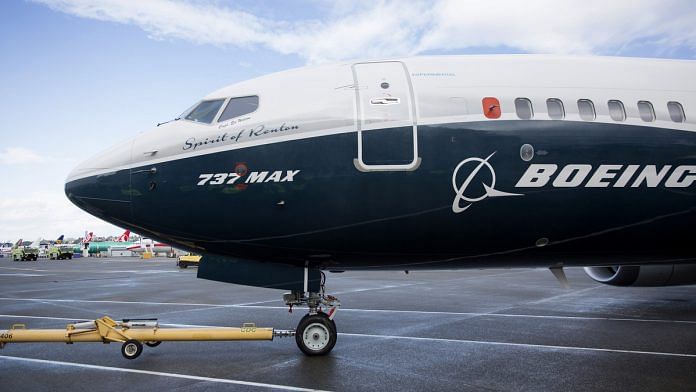New Delhi: The original safety analysis of the MCAS system on Boeing’s 737 MAX jets, which “was used to certify the plane as safe to fly” in 2015, had “several crucial flaws”, says a report in The Seattle Times.
The report, published on 17 March, has not only called into question the safety analysis document but also the manner in which the Federal Aviation Administration (FAA), the aviation watchdog in the US, had granted approval for the MCAS (Manoeuvring Characteristics Augmentation System) software on the Boeing 737 MAX jets.
According to The Seattle Times, the FAA had delegated a part of the safety assessment of the 737 MAX to Boeing itself, and had then worked to “speedily approve the resulting analysis”. Boeing, as a result, had itself conducted the safety analysis of MCAS and submitted the document to FAA for approval.
The MCAS is a flight control software that Boeing introduced in its 737 MAX as the jet’s larger engines had been been placed farther forward on the wing, changing the plane’s aerodynamics.
It is under scrutiny as two crashes in the past five months, involving the 737 MAX, are suspected to have been caused by malfunctioning MCAS’s.
The latest crash was that of Ethiopian Airlines 302, which went down on 10 March, killing all 157 people onboard. In October, an Indonesian Lion Air 737 MAX 8 crashed, killing all 189 people onboard.
Since the Ethiopian Airlines crash, aviation authorities across the world have grounded the Boeing 737 MAX.
Also read: Black Box shows similarities in Lion Air, Ethiopian Boeing 737 Max crashes
Paper had sought Boeing, FAA response before Ethiopian crash
The report, by the paper’s aerospace reporter Dominic Gates, says that it had contacted both the FAA and Boeing over the safety analysis report, even before the Ethiopian Airlines crash.
According to the paper, the FAA only responded on 15 March, five days after the Ethiopian Airlines crash, and said that it had followed “ its standard certification process on the MAX”.
Boeing, the report says, responded a day later, on 16 March, saying that “the FAA considered the final configuration and operating parameters of MCAS during MAX certification, and concluded that it met all certification and regulatory requirements.”
The report added that Boeing said that it was “unable to comment … because of the ongoing investigation” into the crashes, adding that “there are some significant mischaracterisations” regarding the MCAS.
What were the problems with the safety analysis document?
According to The Seattle Times, Boeing’s ‘System Safety Analysis’ document had a number of critical flaws. The newspaper report says that MCAS works by swivelling an aircraft’s horizontal tail, to push the nose of the plane down to avert a stall. “(But) when the planes later entered service, MCAS was capable of moving the tail more than four times farther than was stated in the initial safety analysis document,” the report says.
Boeing’s safety analysis document, the report says, “assessed a failure of the system as one level below catastrophic”.
“But even that “hazardous” danger level should have precluded activation of the system based on input from a single sensor — and yet that’s how it was designed,” it adds.
The report further said that Boeing “failed to account for how the system could reset itself each time a pilot responded, thereby missing the potential impact of the system repeatedly pushing the airplane’s nose downward”.
Boeing’s document, the report says, concluded that the system complied with all applicable FAA regulations.
Also read: Off-duty pilot saved ‘diving’ Boeing 737 Max day before Indonesia crash that killed 189



